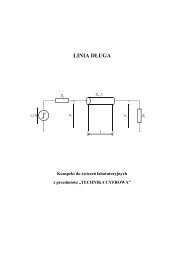9 Interlayer Exchange Interactions in Magnetic Multilayers
9 Interlayer Exchange Interactions in Magnetic Multilayers
9 Interlayer Exchange Interactions in Magnetic Multilayers
Create successful ePaper yourself
Turn your PDF publications into a flip-book with our unique Google optimized e-Paper software.
338 9 <strong>Interlayer</strong> <strong>Exchange</strong> <strong>Interactions</strong> <strong>in</strong> <strong>Magnetic</strong> <strong>Multilayers</strong><br />
coefficient to states of an imag<strong>in</strong>ary wavevector, which is straightforward. One can<br />
check that, with this generalization, Eq. (12) acounts properly for the contribution<br />
of the evanescent states. Physically, this can be <strong>in</strong>terpretated as coupl<strong>in</strong>g of A and B<br />
by a tunnel effect [73, 74].<br />
9.4.1.2 Energy Associated with the Quantum Interferences <strong>in</strong> the Spacer<br />
Let us now study the modification of the energy of the system which results from the<br />
quantum <strong>in</strong>terferences. To conserve the total number of electrons it is convenient<br />
to work with<strong>in</strong> the grand-canonical ensemble, and to consider the thermodynamic<br />
grand-potential, which is given by:<br />
+∞ <br />
εF − ε<br />
≡−kBT ln 1 + exp<br />
n(ε) dε<br />
kBT<br />
=−<br />
−∞<br />
+∞<br />
−∞<br />
At T = 0, this reduces to:<br />
≡<br />
=−<br />
εF<br />
−∞<br />
εF<br />
N(ε) f (ε) dε. (13)<br />
(ε − εF) n(ε) dε<br />
−∞<br />
N(ε) dε (14)<br />
The energy E associated with the <strong>in</strong>terferences is the contribution to correspond<strong>in</strong>g<br />
to N(ε):<br />
E = 2<br />
π Im<br />
+∞<br />
−∞<br />
<br />
ln 1 − rArB e iqD<br />
dε. (15)<br />
9.4.1.3 Three-dimensional Layered System<br />
Generalization of the above discussion to the more realistic case of a threedimensional<br />
layered system is immediate. Because the system is <strong>in</strong>variant by translation<br />
parallel to the plane, the <strong>in</strong>-plane wavevector k is a good quantum number.<br />
Thus, for a given k, one has an effective one-dimensional problem analogous to<br />
that discussed above. The result<strong>in</strong>g effect of quantum <strong>in</strong>tereferences is obta<strong>in</strong>ed by<br />
summ<strong>in</strong>g on k over the two-dimensional Brillou<strong>in</strong> zone. The modification of the<br />
<strong>in</strong>tegrated density of states per unit area is:<br />
N(ε) =− 1<br />
<br />
Im d<br />
2π 3 2 <br />
k ln 1 − rArB e iq⊥ D <br />
(16)<br />
and the <strong>in</strong>terference energy per unit area is:<br />
E = 1<br />
<br />
Im d<br />
2π 3 2 +∞ <br />
k f (ε) ln 1 − rArB e iq⊥ D <br />
dε (17)<br />
−∞



